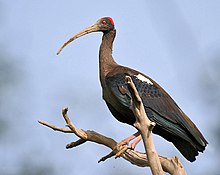Black ibis
| Red-naped ibis | |
|---|---|
 |
|
| Scientific classification | |
| Kingdom: | Animalia |
| Phylum: | Chordata |
| Class: | Aves |
| Order: | Pelecaniformes |
| Family: | Threskiornithidae |
| Genus: | Pseudibis |
| Species: | P. papillosa |
| Binomial name | |
|
Pseudibis papillosa (Temminck, 1824) |
|
 |
|
| Approximate distribution range | |
| Synonyms | |
|
Inocotis papillosus |
|
| Measurements | |||
|---|---|---|---|
| India | |||
| Culmen | 138–158 mm (5.4–6.2 in) | ||
| Wing | 365–400 mm (14.4–15.7 in) | ||
| Tail | 165–194 mm (6.5–7.6 in) | ||
| Tarsus | 75–85 mm (3.0–3.3 in) | ||
Inocotis papillosus
The red-naped ibis (Pseudibis papillosa) also known as the Indian black ibis or black ibis is a species of ibis found in the plains of the Indian Subcontinent. Unlike other ibises in the region it is not very dependent on water and is often found in dry fields a good distance away from water. It is usually seen in loose groups and can be told by the nearly all dark body with a white patch on the shoulder and a bare dark head with a patch of crimson red warty skin on the crown and nape. It has a loud call and is noisy when breeding. It builds its nest most often on the top of a large tree or palm.
The red-naped ibis is a large black bird with long legs and a long downcurved bill. The wing feathers and tail are black with blue-green gloss while the neck and body are brown and without gloss. A white patch on the shoulders stands out and the top of the featherless head is a patch of bright red warty skin. The warty patch, technically a caruncle, is a triangular patch with the apex at the crown and the base of the triangle behind the nape that develops in adult birds. The iris is orange red. Both sexes are identical and young birds are browner and initially lack the bare head and crown. The bills and legs are grey but turn reddish during the breeding season. The toes have a fringing membrane and are slightly webbed at the base.
They are usually silent but call at dawn and dusk and more often when nesting. The calls are a series of loud braying, squealing screams that descend in loudness.
This species can be confused with the glossy ibis when seen at a distance but the glossy ibis is smaller, more gregarious, associated with wetlands and lacks the white on the wing and has a fully feathered head.
The species was first given its scientific name by Temminck in 1824. He placed it in the genus Ibis but it was separated into the genus Inocotis created by Reichenbach and this was followed by several major works including the Fauna of British India although the genus Pseudibis in which Hodgson had placed the species had precedence based on the principle of priority. The red-naped ibis (P. papillosa) included the white-shouldered ibis as P. papillosa davisoni, a subspecies, from 1970 but these are now treated as distinct species, although closely related. The main morphological difference between the two species is seen in the crown and the upper neck. While P. papillosa has a patch of red tubercles on the back of the crown, P. davisoni lacks it. Also, adult P. papillosa have a narrow, bright red mid-crown that becomes broader on the hindcrown, whereas, adult P. davisoni has a bare pale blue middle hindcrown that extends to the upper hindneck and forms a complete collar around the upper neck.
...
Wikipedia

